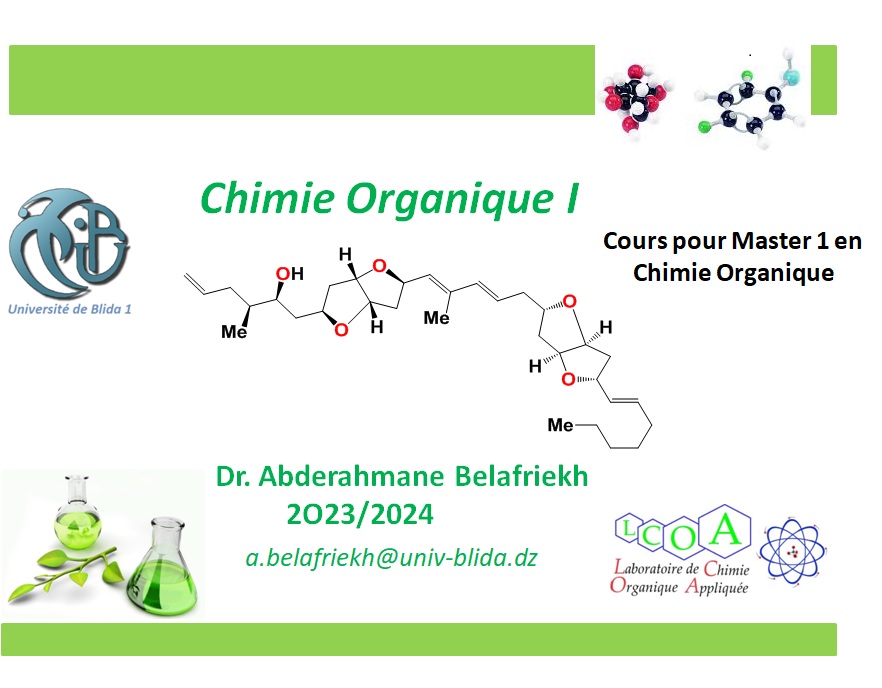Master

Ce cours propose une vue d'ensemble des principes fondamentaux liés aux médicaments, couvrant tout le processus, depuis la découverte des molécules actives jusqu'à leur transformation en produits pharmaceutiques finis. En outre, il traite des différentes origines des matières premières utilisées dans la fabrication des médicaments, qu'elles soient d'origine naturelle, synthétique ou biologique, en mettant l'accent sur la diversité des sources, telles que les plantes, les animaux et les micro-organismes. Enfin, les méthodes de production des substances actives, incluant la chimie des produits naturels, la chimie de synthèse et la chimie verte, sont explorées, avec une attention particulière portée aux approches durables et respectueuses de l'environnement.
- Enseignant: HAMICHE Sonia

Il s'agit d'un support de cours de chimie organique I désigné aux étudiants en 1 ère année master en chimie organique. L'objectif de ce module est d'approfondir les acquis des étudiants en chimie organique par la connaissance des propriétés de certains types de composés, les procédés de protections de fonctions, la rétro-synthèse et les notions de synthèse asymétrique.
- Enseignant: Belafriekh Abderahmane
An introduction to Chemistry in the English language.
This lesson embarks on a journey through pivotal milestones in the realm of chemistry. From the discovery of elements like gold and silver to the revolutionary concept of atoms by Democritus, and the understanding that elements are fundamental building blocks forming new substances, each step reshaped our perception of matter. Dmitri Mendeleev's creation of the Periodic Table provided a structured framework to comprehend and predict elements' behaviors, resembling an organized collection guiding further scientific exploration.
- Enseignant: cherfa nesrine
Le cours et le TP d'informatique pour la chimie (introduction à la modélisation moléculaire) sont destinés aux étudiants de 3LCA
- Enseignant: Ati Fella

https://youtu.be/maQ_Gd7TapI?si=J1cPTQColMFz7gKw
- Enseignant: cherfa nesrine
In this engaging exploration of English pronunciation, we navigated the intricacies of -S endings through three distinctive sounds: /s/, /z/, and /IZ/. By examining the sounds preceding the -s, we unveiled the key to its pronunciation. When the preceding sound is unvoiced (/k/, /p/, /f/, /t/, /th/), the -s adopts the crisp /s/ sound. Conversely, voiced consonants (/g/, /d/, /v/, /m/, /ng/) prompt the -s to take on the buzzing /z/ sound. Additionally, words ending in -es or specific letters—s, ks, j, ch, sh, z—resonate with the distinct /IZ/ pronunciation. This lesson served as a roadmap, equipping learners with strategies to confidently decipher the nuanced sounds of -S endings in English words.
- Enseignant: cherfa nesrine
The journey of Dmitri Mendeleev, marked by adversity and resilience, led to his groundbreaking work in creating the periodic table of elements. Mendeleev noticed patterns among elements that defied their traditional arrangement by atomic weights. Through meticulous observation and relentless determination, he arranged elements based on their properties and recurring patterns rather than their weights, introducing gaps that predicted undiscovered elements. His 1869 periodic table not only organized known elements but remarkably foretold the existence and properties of elements yet to be discovered, becoming an invaluable blueprint for future scientific exploration and a testament to human ingenuity.
- Enseignant: cherfa nesrine
